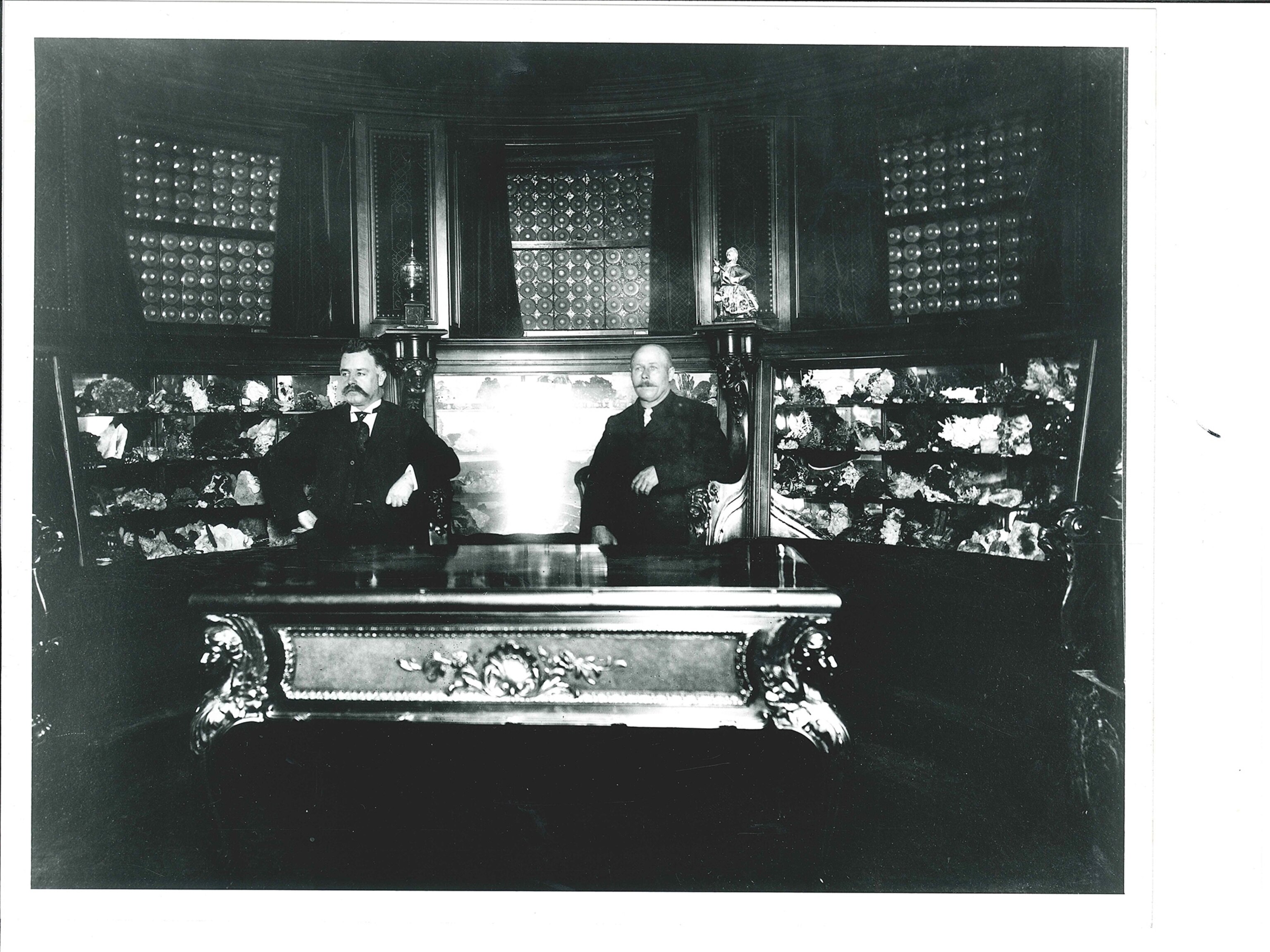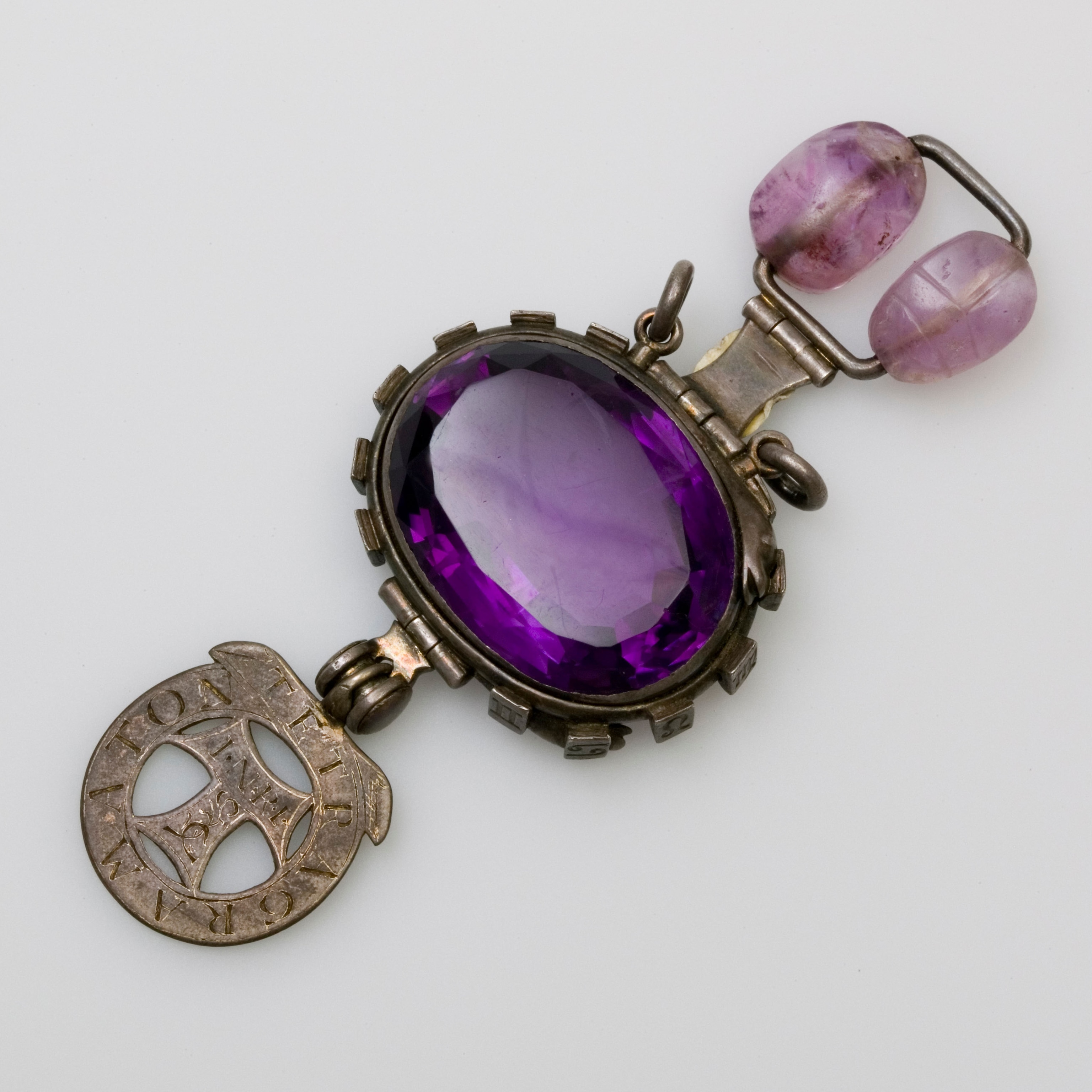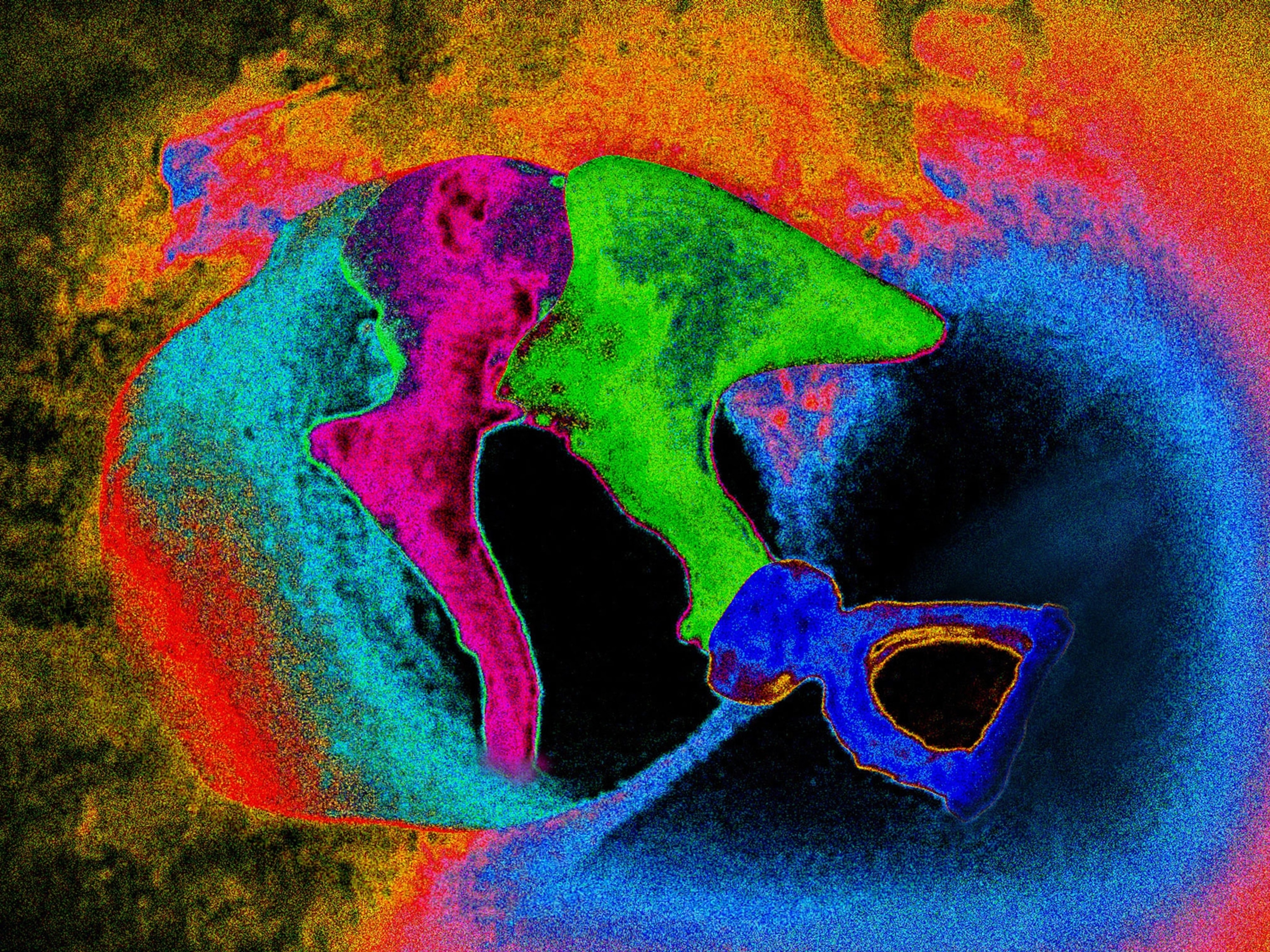In 1887, as Colorado's gold production neared its peak, the Ground Hog mine near the town of Gilman yielded an unexpected treasure: a ropey branch of gold that split into a trio of curling tendrils. Standing just over 4.7 inches tall and weighing roughly half a pound, the yellow curlicues of precious metal represent the rarest form of gold ever found.
“It’s truly a unique object—there’s nothing even comparable to it,” says John Rakovan, a mineralogist at Miami University in Ohio. This rarity, however, has a scientific down side: No one wanted to damage or cut the few known samples of wire gold to do the tests necessary to figure out how they formed. For decades, the tendrils remained a gorgeous enigma.
Now, researchers just got their first peek inside the exquisite sample, known as the Ram's Horn, with the assistance of a half-mile-long particle accelerator at Los Alamos National Laboratory. The results revealed that the bundle, which seems to be dozens of glimmering golden wires, is actually either one massive crystal or only a few crystals growing together.
The new work with wire gold is not yet published in a peer-reviewed journal, but the geology community is already enthusiastic about a preview recently issued by the Los Alamos lab. The results and those of future studies could have wide-ranging implications, from contributing to more efficient mining techniques to finding new uses for gold in metal-dependent technologies, says Raquel Alonso-Perez, curator of the Harvard museum that currently houses the horn.

“What they’ve done is fantastic, and no doubt they’re going to go flesh this out some more,” says James Hagadorn, who is curator of geology at the Denver Museum of Nature and Science, which hosts other wire gold samples from Colorado's Ground Hog mine. “We had thought about doing the same thing with our specimens.” (Find out how studying some of the world's oldest rocks revealed that meteors delivered gold and other precious metals to the young Earth.)
“It’s all very new and pretty exciting stuff,” adds Aaron Celestian, a curator of mineral sciences at the Natural History Museum of Los Angeles, which also houses wire gold.
Golden toothpaste
Mining for gold may conjure mental images of shiny nuggets rounded by their trips down streams. But gold can also grow into stunning crystals as it emerges from naturally heated, mineral-rich waters flowing through rocky crevices. When these crystals are elongated, they’re often called wires.
“It’s kind of like a gorilla stepped on a tube of toothpaste—except it’s solid gold,” Hagadorn says.
While such smooth gold wires are relatively common, true wire gold is exceedingly rare. It can be identified from grooves that run down its length, as if the metal had been piped from a pastry bag, Hagadorn says, earning it the name striated wire gold. The number of deposits known to produce such samples could probably be counted on one hand, by Rakovan's estimation.
The Ram's Horn currently resides in Harvard's Mineralogical and Geological Museum. It arrived at the museum in the mid-1900s as part of an impressive mineral collection bequeathed by Harvard alumnus Albert C. Burrage. At the time of its discovery, the gold horn was valued at U.S. $160 by weight—or about $4,500 in today's currency. Rakovan declined to state its current value due to security concerns, saying only that it's worth “a very pretty penny.”

In February 2018, at Tucson's annual Gem and Mineral show, Alonso-Perez reached out to Rakovan to gauge his interest in studying the gold horn. Still remembering visits to see the sparkly sample in the museum as a kid, he didn't hesitate. He and his team paired up with researchers at Los Alamos National Laboratory in hopes of deciphering the horn's crystal structure using non-damaging techniques.
But that raised a mighty challenge: transporting a priceless object that is subject to a slew of safety protocols from Massachusetts to New Mexico.
“We worked for months to get all the paperwork and policies in place,” says Alonso-Perez, who adds that research in a nuclear facility only upped the pile of paperwork. But eventually, the hunk of gold made the trip.
“That’s probably the most valuable item that I ever held in my hand or put my hands on,” says Sven Vogel, a physicist at Los Alamos National Laboratory's neutron science center.
Silver and gold
At Los Alamos, the team bombarded the sample with neutrons, one of the subatomic building blocks of atoms, which could penetrate the gold's surface. When these particles strike crystal structures, they skitter away in various directions. For a sample made of a single crystal, the scattered neutrons tend to follow just a few paths. The more crystals present, the more scattered the paths become, smearing out the signals.
The team's analysis revealed that the golden horn was likely made of just a few crystals, rather than the apparent multitude. The team also analyzed a much smaller specimen from Colombia, which curls in a single spiral, and it also appears to be made of surprisingly few crystals.
This conclusion stands in stark contrast to wire silver, the shimmery cousin to wire gold that's much more commonplace. In previous work, researchers had sliced into those silvery samples and found that they are made up of an interlocked bundle of many crystals.
For wire gold, the researchers also looked for the absorbed neutrons, which revealed another surprise: both samples are actually gold alloys that include up to 30 percent silver. Additional work at LANL with powerful x-rays—over a hundred times more energetic than those used in medical scans—confirmed that the density, and thus the composition, is similar throughout each sample.

Fulfilling a mission
What all this means is still up for debate, but some clues may come from a new study published in Geology that digs into the mechanism behind wire silver formation. For that work, Rakovan and a different team of researchers grew synthetic wire silver from silver sulfide to tease apart how they form. This ability to synthetically grow wire silver was documented as early as the 1500s, when miners smelting silver ore reported sparkly metal hairs springing up as they worked. A similar method was harnessed in this new work, by creating a temperature gradient across a rock of silver sulfide.
The wire's formation comes from a peculiar property of silver sulfide known as superionic conduction, which means silver ions—aided by temperature or electric gradients—race through solid rock at surprisingly high rates, Rakovan explains. These high-speed silver atoms collect at the rock's surface, eventually pushing the tip of the wire up and away, continuing to elongate as more silver builds at its base. In as little as half an hour, the researchers could grow wires as long as 0.3 inches.
“You can see it grow in front of your eyes,” Rakovan says.
Perhaps this speed is why wire silver has so many interlocked crystals, the researchers postulate. Gold is much less reactive and doesn't naturally form sulfides, so it may grow much slower and thus form bigger and fewer crystals. Rakovan compares the process to building a brick wall.
“If you built that brick wall really slowly, you’d get a nice flat, straight wall,” he says. “But if everybody was hurrying and throwing their bricks down and cementing them together, it would be all full of defects—and, essentially, those defects are [crystal] grain boundaries.” Future high-tech studies on both gold and silver could help tease out some of these answers.









“We've learned more about wire silver in the last two years than what's been learned in the last 400 years,” Rakovan adds. “It’s pretty amazing what we’re coming up with.”
For Alonzo-Perez, the work holds an even bigger meaning: “I feel like we fulfilled the mission of museum collections,” she says.
While museums are major components of public education, they're also a repository to safeguard our natural history for future generations of scientists, who can tackle more complex questions using ever more sensitive tests—like using a particle accelerator to study a gold sample discovered over a century before.
“Most of the museum collections, they get used for display; people come and enjoy,” she says. “But I think deep down, the purpose is science and research—and moving science forward.”
You May Also Like
Go Further
Animals
- Octopuses have a lot of secrets. Can you guess 8 of them?
- Animals
- Feature
Octopuses have a lot of secrets. Can you guess 8 of them? - This biologist and her rescue dog help protect bears in the AndesThis biologist and her rescue dog help protect bears in the Andes
- An octopus invited this writer into her tank—and her secret worldAn octopus invited this writer into her tank—and her secret world
- Peace-loving bonobos are more aggressive than we thoughtPeace-loving bonobos are more aggressive than we thought
Environment
- Listen to 30 years of climate change transformed into haunting musicListen to 30 years of climate change transformed into haunting music
- This ancient society tried to stop El Niño—with child sacrificeThis ancient society tried to stop El Niño—with child sacrifice
- U.S. plans to clean its drinking water. What does that mean?U.S. plans to clean its drinking water. What does that mean?
- Food systems: supporting the triangle of food security, Video Story
- Paid Content
Food systems: supporting the triangle of food security - Will we ever solve the mystery of the Mima mounds?Will we ever solve the mystery of the Mima mounds?
History & Culture
- Strange clues in a Maya temple reveal a fiery political dramaStrange clues in a Maya temple reveal a fiery political drama
- How technology is revealing secrets in these ancient scrollsHow technology is revealing secrets in these ancient scrolls
- Pilgrimages aren’t just spiritual anymore. They’re a workout.Pilgrimages aren’t just spiritual anymore. They’re a workout.
- This ancient society tried to stop El Niño—with child sacrificeThis ancient society tried to stop El Niño—with child sacrifice
- This ancient cure was just revived in a lab. Does it work?This ancient cure was just revived in a lab. Does it work?
Science
- The unexpected health benefits of Ozempic and MounjaroThe unexpected health benefits of Ozempic and Mounjaro
- Do you have an inner monologue? Here’s what it reveals about you.Do you have an inner monologue? Here’s what it reveals about you.
- Jupiter’s volcanic moon Io has been erupting for billions of yearsJupiter’s volcanic moon Io has been erupting for billions of years
- This 80-foot-long sea monster was the killer whale of its timeThis 80-foot-long sea monster was the killer whale of its time
Travel
- How to plan an epic summer trip to a national parkHow to plan an epic summer trip to a national park
- This town is the Alps' first European Capital of CultureThis town is the Alps' first European Capital of Culture
- This royal city lies in the shadow of Kuala LumpurThis royal city lies in the shadow of Kuala Lumpur
- This author tells the story of crypto-trading Mongolian nomadsThis author tells the story of crypto-trading Mongolian nomads







